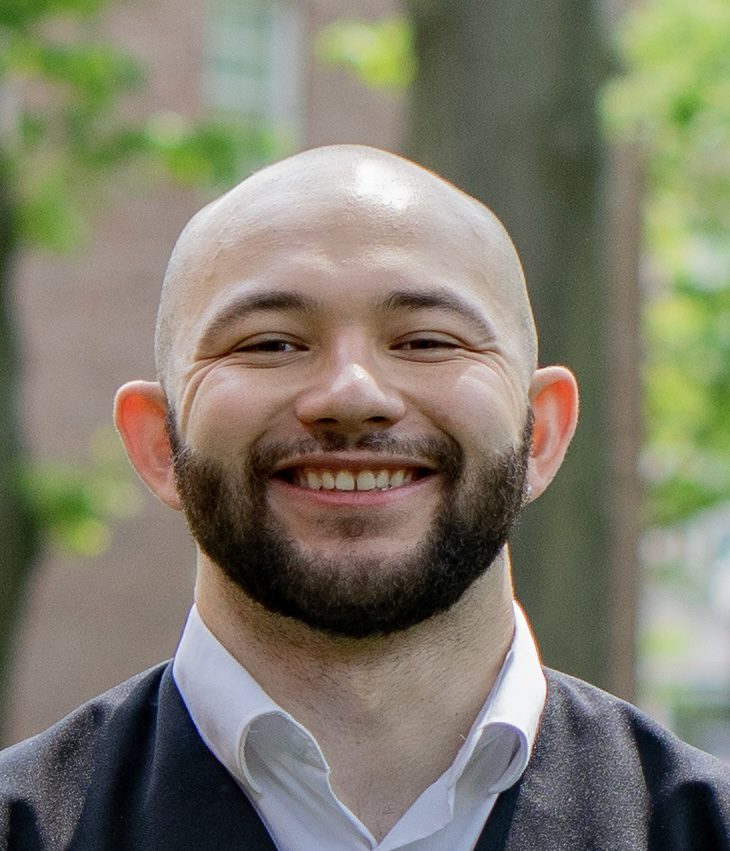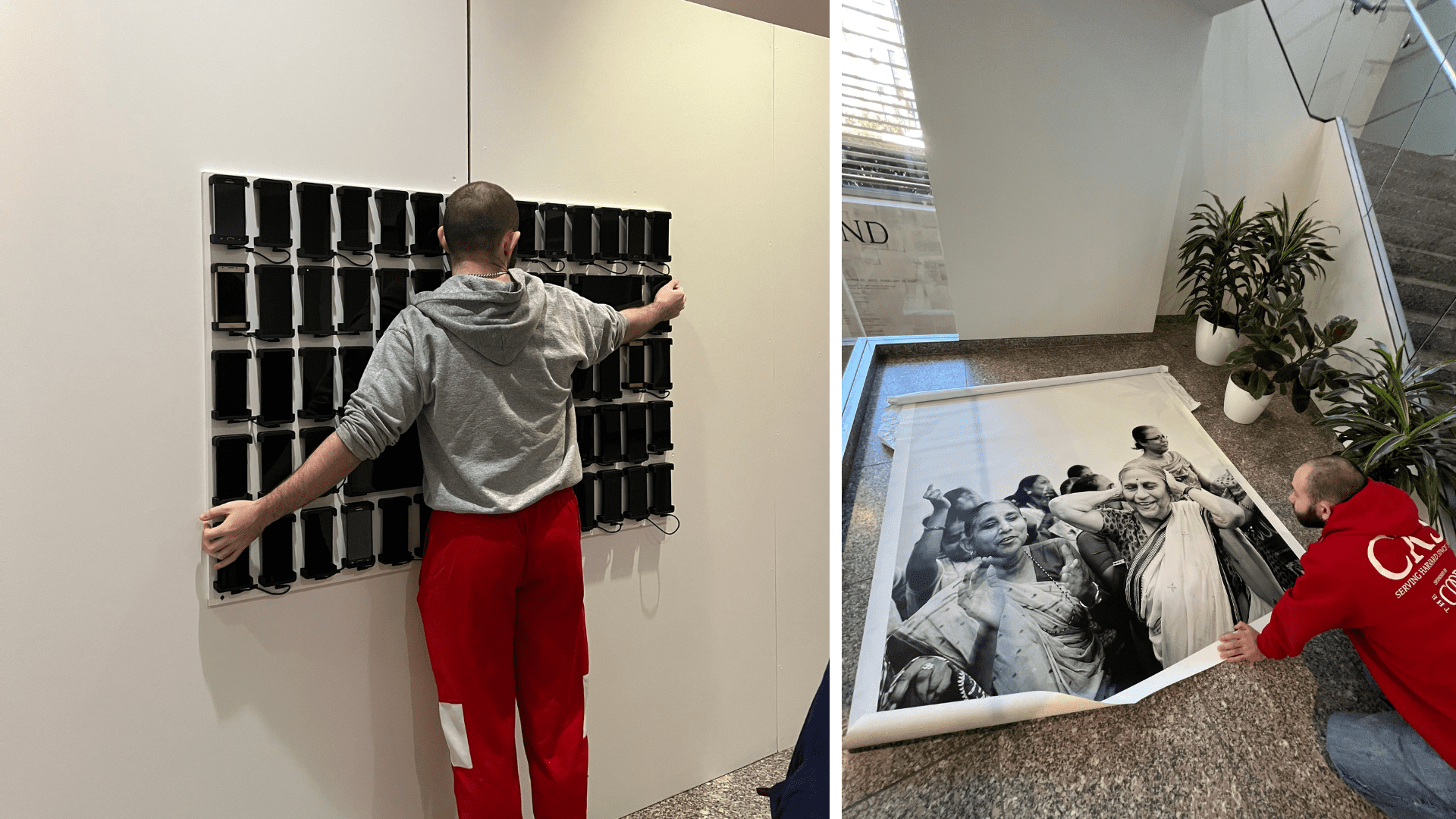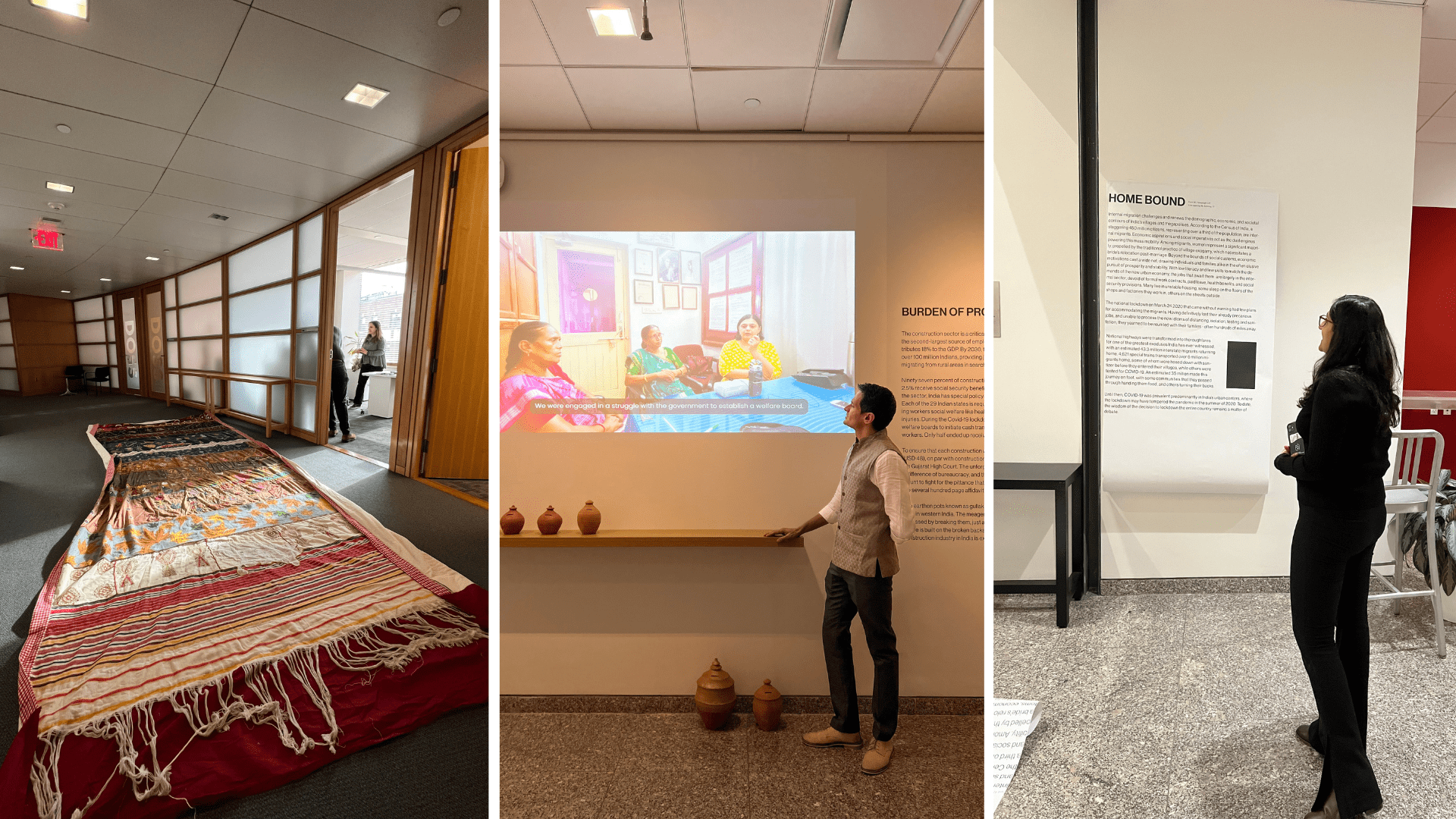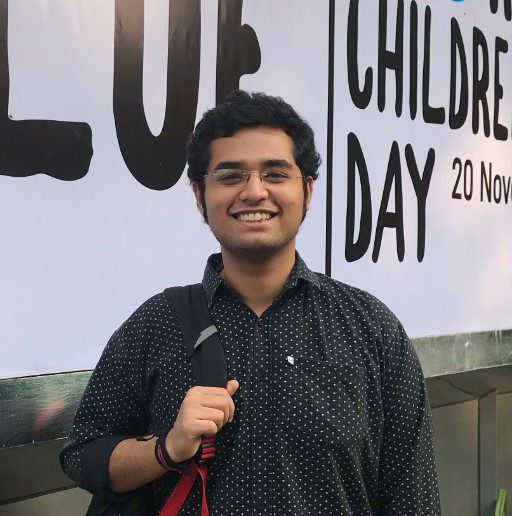The multimedia exhibition HUM SAB EK (We Are One) launched this past week at CGIS South (read an interview with project leader Dr. Satchit Balsari here). Ahead of the April 15 Opening Reception, we spoke with some of the students who volunteered their time to make this exhibition a reality. Few had prior experience bringing an exhibit to life, yet they all pitched in to make it a reality. They hail from departments and schools across Harvard, with a variety of academic backgrounds and interests. Together they created something powerful, and look forward to bringing their immersive show to sites around the U.S. in in South Asia.


Behind-the-scenes images of creating the HUM SAB EK exhibit.
Hiteshree Das, MDes ’25 (Harvard Graduate School of Design)
Mittal Institute: What was your role in the exhibition – how did you help?
Hiteshree Das: I’ve been fortunate to design and co-curate this exhibition alongside Dr. Satchit Balsari. We envision the project HUM SAB EK as a two-year long multi-pronged initiative to effectively convey SEWA’s pandemic response story to academics, policy-makers, creatives, and citizens who are still grappling with the aftermath of the pandemic, both in India and globally. This initiative comprises a traveling exhibition, archival resources, and seminars to engage a wide-ranging audience.

To kickstart the project, we undertook the task of transcribing and translating 30 hours of SEWA members’ testimonies from Gujarati to English. Simultaneously, I delved into Dr. Balsari’s field notes from 2022 to grasp SEWA members’ experiences and develop a preliminary catalog for our envisioned traveling exhibition using digital collage as a medium. Towards the end of this phase, I visited SEWA in Ahmedabad, conducting interviews with the members to present our exhibition proposal and refine it based on their feedback. We engaged with various subject matter experts, multilateral organizations, museums, and think tanks to introduce our project proposal and establish partnerships for this unique art-science collaboration. And by the end of January 2024, we had formed a strong interdisciplinary team consisting of engineers, researchers, filmmakers, and designers.
The several iterations of the proposed exhibition design catalog served as a broad framework for the individual installations that were detailed by our team members. For example, I had rendered an initial vision for our ‘You Are On Mute’ installation, showcasing SEWA’s massive digital literacy drive. This was depicted through 100 smartphones arranged asymmetrically, each lighting up sequentially to symbolize the multitude of Zoom calls the members engaged in—despite lacking any expertise in programming video loops or video editing. Soon, Bobby began experimenting by splitting a video across two phones, eventually escalating to over 70 devices to realize our vision. Deepak collaborated with him to sift through a myriad Zoom recordings to create a three-minute video montage showcased on the phones. Meanwhile, William constructed the framework that supports the installation, completing the task over a single weekend.
As the team worked on their individual installations asynchronously, I also took on the responsibility of coordinating with the venue’s building services team and the fabricators to ensure a significant part of the installation was completed over the spring break. This experience opened up a new realm of learning for me about spatial codes within the university, which differed significantly from my previous work as an exhibition designer in India.
Mittal Institute: Why did you decide to get involved in the first place?
Hiteshree Das: I enrolled in the GSD’s Masters of Design Studies program with the goal of expanding my skillset beyond traditional industrial and exhibition design. I was eager to explore an overlap between design and deep social science research and believed that the liberal arts environment at Harvard would support this pursuit, although I wasn’t sure how at the time. One day, before the class of the course GENED 1011: Entrepreneurial Solutions for Intractable Problems, co-taught by Dr. Balsari, I struck up a conversation with him about a recent trip to India, where he had interviewed informal working women. He was contemplating the idea of creating an archive and I was intrigued by the fact that a physician was exploring this concept and felt that it was something I could contribute to, especially considering my previous experience working with India’s first virtual museum through Google Arts and Culture. Now, a year later, we have developed a comprehensive exhibition that aims to start conversations about ways to include communities in policy decisions that impact their lives and livelihoods.
Mittal Institute: What did it mean to you to be involved in this project? What are you most proud of?
Hiteshree Das: Being part of this project has allowed me to evolve and reshape my design practice using systems thinking and participatory research approaches, while gaining a deeper understanding of the responsibilities associated with being a designer and researcher. I now view design as a process of negotiation–one that involves the democratic collection and creation of knowledge, and facilitates its sharing for collective objectives while carefully weighing trade-offs influenced by socio-political, economic, and geographic factors.
I believe that through this journey of learning about SEWA and contributing to this exhibition, we absorbed SEWA’s values into our curatorial and design approach, albeit at a subtle level. Despite our initial lack of clarity, there was a strong foundation of trust demonstrated by the team which provided a lot of freedom to make mistakes and learn iteratively. I am proud of the fact that despite limited resources, technical challenges, and time constraints, we did not compromise on the shared vision of the project.
Robert McCarthy, BA ’23 (Harvard College)
Mittal Institute: What was your role in the exhibition – how did you help?
Robert McCarthy: My role was to prototype and build the phone component of the ‘You Are On Mute’ exhibit. So I programmed the system that cropped the videos and synchronized them across the phones, I built the cases that were used to mount the phones to the wall, and I edited the videos that went onto the phones.
Mittal Institute: Why did you decide to get involved in the first place?
Robert McCarthy: Originally they had asked the professor for the class that I am a teaching assistant for, but he did not have the free time to work on the project, so he asked me if I wanted to get involved. Before I even knew about the material of the exhibit, ‘You Are On Mute’ was just a very interesting engineering problem to solve, but once they told me more about SEWA, taking on this project was a no brainer.

Mittal Institute: What did it mean to you to be involved in this project? What are you most proud of?
Robert McCarthy: I think I am proud of this exhibit for two reasons. One from an engineering perspective, this had been the biggest engineering project I had taken on to this point, so I am just proud that I was able to get the exhibit running. Second, I am just proud to have been a part of an exhibit that displays these powerful stories. In my life, I have not done anything extraordinarily powerful or meaningful, so to use my engineering skills to be able to show what SEWA was able to overcome during the pandemic makes me happy.
A prototype of the “You Are On Mute” exhibit | Video courtesy of Robert McCarthy.
Deepak Ramola, EdM ’23 (Harvard Graduate School of Education)
Mittal Institute: What was your role in the exhibition – how did you help?
Deepak Ramola: I was a member of the design team and assisted in curating all the video assets featured in the showcase such as the ‘You Are On Mute’ exhibit and oral history short films. This entailed reviewing, shortlisting, and creating excerpts from the 30+ hours of oral history recordings captured by Professor Balsari during his field trips.
Mittal Institute: Why did you decide to get involved in the first place?
![Deepak Ramola[95]](https://mittalsouthasiainstitute.harvard.edu/wp-content/uploads/2024/04/Deepak-Ramola95-2-scaled.jpg)
Deepak Ramola: I’ve always been a firm believer in the wisdom and resilience of everyday people, and the women of SEWA epitomize this belief. Their stories reflect their grounded lives and aspirational dreams, showcasing the intersection of possibility and determination through resilience, hard work, and hope. Joining this project from its inception provided me with the chance to sit with some of India’s most inspiring women and hear their stories firsthand. Who could pass up such a remarkable opportunity for a masterclass in empowerment?
Mittal Institute: What did it mean to you to be involved in this project? What are you most proud of?
Deepak Ramola: Words like “innovation,” “path-breaking,” and “revolutionary” are rarely associated with marginalized communities and the impoverished. Yet, delving into the world of SEWA and witnessing the vibrant legacy of its members, these are the only descriptors that seem fitting. Throughout the project, I navigated between two contrasting worlds: from the bustling streets of India to the quiet lanes of Cambridge. The unspoken dialogue between these worlds, characterized by mutual respect, enabled us to design with sensitivity and care. I take the greatest pride in the collaborative effort of every team member, coming together to envision, design, and deliver this truly unique exhibition experience.


Constructing and designing the exhibit | Photos by Deepak Ramola.
Karthik Girish, MUP ’25 (Harvard Graduate School of Design)
Mittal Institute: What was your role in the exhibition – how did you help?
Karthik Girish: I played the role of data visualizer and designer. I helped by converting data and statistics into visual pieces that conveyed powerful stories and information. I have a vendetta against pie charts and bar graphs, so I sit and think of ways to represent data through visually appealing but factually correct graphics.

Mittal Institute: Why did you decide to get involved in the first place?
Karthik Girish: My entry into the project was unexpected. Initially, I was onboarded to design exhibit description panels and resize images. Having no experience working on a project of this scale, I was thrilled to work and learn more. But before I got my initial tasks, Dr. Balsari asked me to make one data graphic. And then another. Then six more after that, I ended up designing the two big-wall graphics for ‘Every Body Counts’ and ‘Super Spreaders’. My love for designing data was fulfilled with every graphic that was created. I enjoyed the iterative design process for such an important and impactful message. This was a surreal experience, and I am highly indebted to Dr. Balsari and Hiteshree for giving me this wonderful opportunity..
Mittal Institute: What did it mean to you to be involved in this project? What are you most proud of?
Karthik Girish: The project was an eye-opener to me. I am happy I used my design tools to spread the effort and voices of poor working women and the SEWA organization. The intention to convey the recorded conversations and stories impactfully drove me and my design process. I am also extremely grateful to have worked with a multi-talented team.
Kartikeya Bhatotia, MPP ’24 (Harvard Kennedy School)
Mittal Institute: What was your role in the exhibition – how did you help?
Kartikeya Bhatotia: I contributed to the editorial and research aspects of the exhibition. After grasping the vision of Dr. Satchit Balsari and Hiteshree, I reviewed the transcripts and read the oral histories of women in SEWA. We brainstormed the types of narratives to highlight from their enriching lives, focusing on their perseverance through the pandemic, which significantly increased their socio-economic precarity. From the experiences of migration to living through one of the harshest lockdowns in the world, these women’s stories are both important to tell and inspiring to hold onto.

Mittal Institute: Why did you decide to get involved in the first place?
Kartikeya Bhatotia: I have been researching the informal economy for years. Although often overlooked in India, it offers deep insights into the narratives of development and growth. As the Head Teaching Fellow for the FAS fall course GENED 1011: Entrepreneurial Solutions for Intractable Problems, co-taught by Dr. Satchit Balsari, I gained a deeper understanding of how entrepreneurs, like the women at SEWA, innovate across the economy’s various sectors. Their stories are not just fascinating; they are crucial for comprehending the intricacies of the Indian economy. This is what drove me to get involved and assist in sharing their experiences.
Mittal Institute: What did it mean to you to be involved in this project? What are you most proud of?
Kartikeya Bhatotia: As someone who lost a loved one in the pandemic, it was deeply important for me to carry forward the narratives of those who endured the worst suffering. To me, this project is a memory-keeping initiative. In popular imagination, the pandemic is about Zoom calls, yoga, and in India’s case, beating pots and pans. It rarely touches on the biggest internal migrant crisis of independent India or the massive undercounting of pandemic-related deaths. I am really proud that I have highlighted both the stories of perseverance and loss. In preserving our histories and keeping them alive, a significant part involves acknowledging how societies and states failed to care for their people. At its core, the project is about policy: it encompasses the world’s largest cash transfers, the complex supply chains of food in India, and it is about reclaiming the popular narrative.
Student Participants
Hiteshree Das, MDes ’25 (GSD), Lead Student Designer and Co-Curator
TECHNOLOGY LEAD
Robert McCarthy, BA ’23 (Harvard College)
DESIGN TEAM
William Boles, MLA ’26 (GSD)
Deepak Ramola, EdM ’23 (HGSE)
Shariq M. Shah, MDes ’24 (GSD)
Karthik Girish, MUP ’25 (GSD)
RESEARCH TEAM
Abhishek Bhatia, MS ’17 (HSPH)
Kartikeya Bhatotia, MPP ’24 (HKS)
Ravi Sadhu, (HSPH)
☆ The views represented herein are those of the interview subjects and do not necessarily reflect the views of LMSAI, its staff, or its steering committee.
